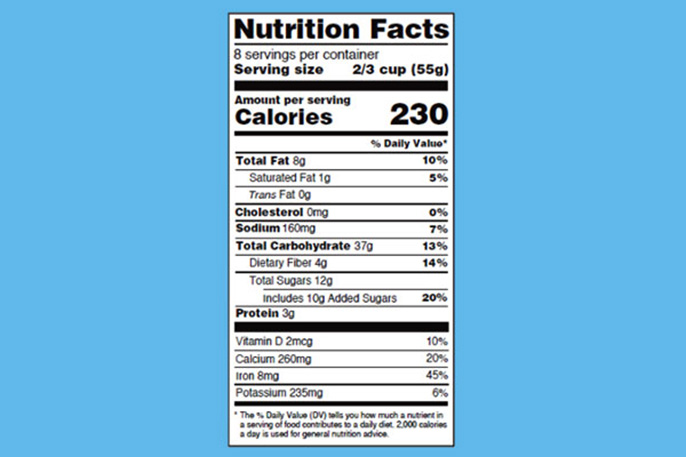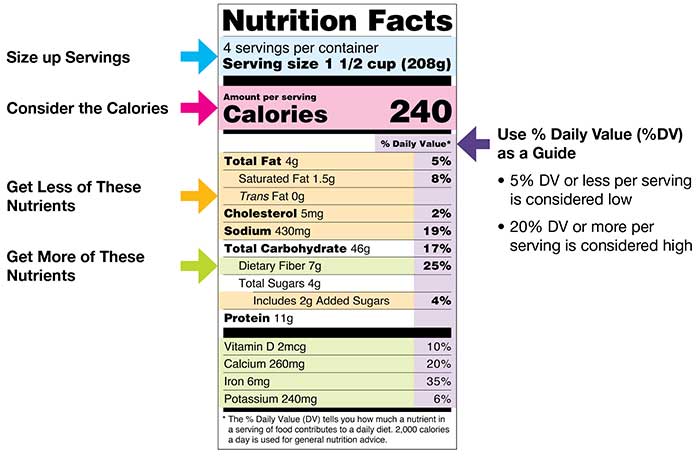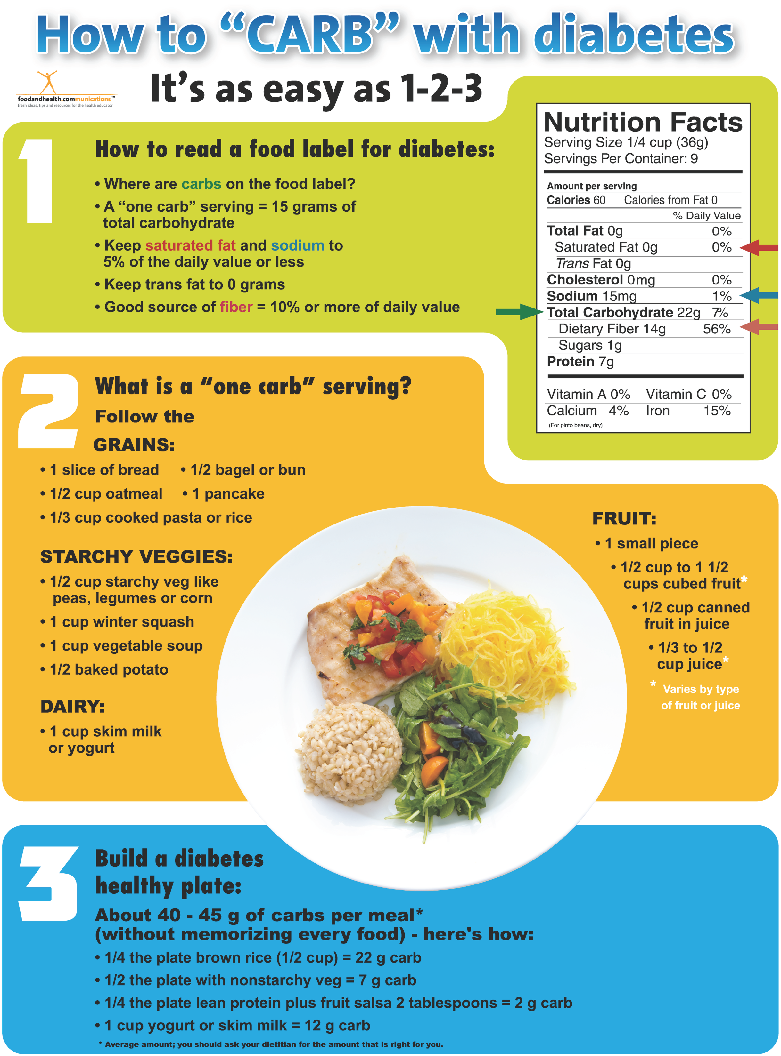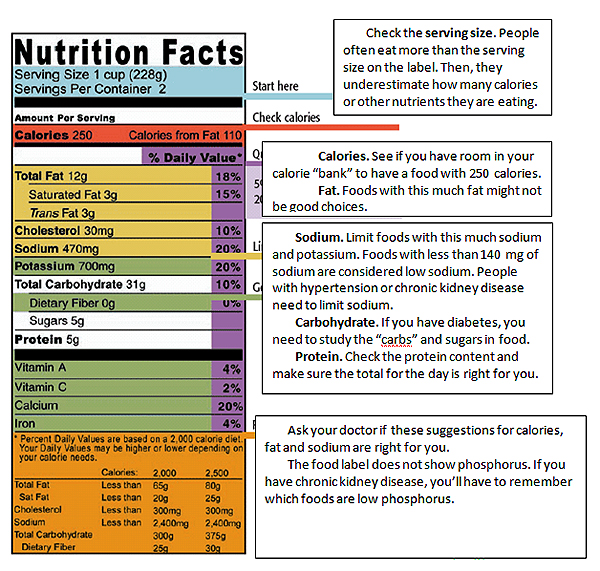45 how to read food labels diabetes
Reading Food Labels When You Have Diabetes - WebMD If a package has four servings and you eat the whole thing (like a bag of crunchy snacks), you get 4 times the calories, fat, and everything else listed on the label. Calories and Calories From Fat... Reading food labels: Tips if you have diabetes - Mayo Clinic Look for foods with 3 or more grams of fiber. Put sugar-free products in their place Sugar-free doesn't mean carbohydrate-free. Sugar-free foods may play a role in your diabetes diet, but remember that it's equally important to consider carbohydrates as well. A sugar-free label means that one serving has less than 0.5 grams of sugar.
How to Read Food Labels | mySugr Before reading the rest of the label, look at the serving size. The rest of the information — such as carbs, calories, sugars, fiber, and more — will be based on the serving size that's listed. Eating more than a serving size means you'll get more carbs, sugars, and calories than what's listed. Looking at the serving size also helps ...

How to read food labels diabetes
How to Read Food Labels When You Have Type 2 Diabetes Quick Tip: When you see sugar-free on a label it means less than 0.5 grams of sugar per serving. No sugar added doesn't mean low or no-carb. A lot of food labels say "no sugar added" but these foods might have tons of carbs. No sugar added simply means no sugar was added during processing or packaging. Sugar alcohols have hidden carbs. PDF Label Reading Basics for Diabetes - Veterans Affairs This food has 300 mg of sodium per ½ cup serving. It is suggested to limit salt intake to 1500 mg per day when you have diabetes. With pre-diabetes, your sodium intake should still be monitored. The goal is less than 2300 mg per day. A good first step is to not have a salt shaker at home. Total Fat The area on the label describing How to read nutrition facts labels - Diabetes Care Community 5 easy steps to reading a Nutrition Facts Table. 1.Look at the serving size. Compare the serving size on the package to the amount that you plan to eat. If you eat the serving size shown on the Nutrition Facts table, you will get the amount of calories and nutrients that are listed.
How to read food labels diabetes. Reading food labels: Tips if you have diabetes - Drugs.com Just as food labels can help you avoid certain foods, food labels can also serve as your guide to free foods. A free food is one with: Fewer than 20 calories a serving; Less than 5 grams of carbohydrates a serving; Do the math. Pay attention to serving sizes. The serving sizes listed on food labels may be different from the serving sizes in ... Learn About Reading Food Labels When You Have Diabetes Food labels become an indispensable tool if your meal strategy is focused on carbohydrate count. Rather than just the grams of sugar, consider the grams of total carbs, which comprises ingredients such as complex carbohydrates, fiber, and added sugars. However, try to consider the total carbohydrates rather than just sugar count. How to Read Food Labels When You Are Diabetic - Diabetics Weekly Study the Carbohydrate Content in Detail This is the most important aspect of how to read food labels when you have diabetes. The total amount of carbohydrates breaks down into complex carbohydrates, sugar, and fiber. Don't hone in on zero-sugar foods, as foods like milk and fruit contain natural sugars. Learn how to read the 2021 Nutrition label. - YouTube … run through the important parts of the label to know for diabetes friendly food choicesEvolve Diabetes LLC is a diabetes support medical services company b...
Reading Food Labels | ADA - American Diabetes Association Put food labels to work. The Nutrition Facts labels on foods are really the key to making the best choices. We'll cover the basics so that these labels make shopping easier for you. You've heard it all. From carb-free to low-carb, to whole and empty carbs, it's hard to know what it all means. Blood sugar highs and lows aren't always ... Diabetes Food Label Reading: Quick Tips to Shop Smarter We recommend skimming the back label and keeping your eyes open for sugar and sugar alternatives that might be hiding somewhere in the ingredients list. Also, make sure to read the fine print underneath those big, bold health claims that take center stage on the front of packaged foods. Learn how to read food labels - Diabetes Care Community People with diabetes have a variety of food considerations to keep in mind. Learn how to read food labels and you'll get a head start in planning meals to meet our diabetes management targets. The first thing to check on a label is the 'serving size'. This is the manufacturer's suggested portion for one person. PDF how To Read food labels HoW To ReaD FooD LaBeLs You don't even have to look at "Sugars" on the label. Try choosing foods that are less than or equal to 25 grams of total carbohydrate per serving. Choose foods that have 3 or more grams of fiber per serving. step 3. look at the "Calories" and the "Total fat." Try choosing foods that are 0-3 grams of total fat for every 100 calorie serving.
Reading Food Labels When You Have Diabetes | HealthLink BC Start with the "% Daily Value" column on the food label. A food is considered low in a specific nutrient (such as fat, saturated fat, cholesterol, carbohydrate, or sodium) if it has 5% or less of the daily value. A food is considered high in that nutrient if it has 15% or more of the daily value. Watch out for health claims on food labels. Food Labels | CDC Check the Serving size first. All the numbers on this label are for a 2/3-cup serving. This package has 8 servings. If you eat the whole thing, you are eating 8 times the amount of calories, carbs, fat, etc., shown on the label. Total Carbohydrate shows you types of carbs in the food, including sugar and fiber. How to Read Nutrition Labels When You Have Diabetes Getting Past the Guilt of Type 2. See how one patient learned to manage her weight and diet. How to read food labels if I have diabetes or prediabetes? Knowing how to read food labels is a very useful skill to improve your eating and better manage or help to prevent the progression of diabetes. There are three main things on the food labels to look out for: nutrition information panel, ingredient list, and Healthier Choice Symbols. 1. Nutrition information panel (NIP)
How to Read a Dietary Supplement Label for Diabetes When reading dietary supplement labels, look for the following information: the total carbs listed in bold letters. Total carbs are carbohydrates in grams. Both sugar and fiber are listed separately. While all carbohydrates raise blood sugar, you should use total carbs as a guide. Fiber can be found in whole-grain bread, fruits, vegetables ...
PDF Label reading basics for diabetes - Veterans Affairs Label Reading Basics for Diabetes Nutrition and Food Services (05/2020) Serving Size • The serving size is the portion size used for all the values on the label. • Different foods have different serving sizes. • The serving size on this label is 2/3 cup. Servings per Container • Indicates the number of
Understanding food labels fact sheet - NDSS Food labels will typically include a nutrition information panel, list of ingredients, the 'use by' or 'best before' date and identify potential food allergens and additives. Food labels also tell you the amount of carbohydrates (carbs) you eat and drink. This can help you manage your blood glucose levels.
How to Read the New Food Label On the new label, added sugars are listed under total sugars. The word "includes" is used before added sugars to indicate they are already included the grams of total sugars. Added sugars are from table sugar, syrups and honey, and sugars from concentrated fruit or vegetable juices. Keep added sugars as low as possible. Protein
Learning To Read Labels :: Diabetes Education Online On a nutrition food label, subtract the fiber from the total carbohydrate amount. When you read food labels, the grams of sugar are already included in the total carbohydrate amount, so you do not need to count this sugar amount separately. The grams of sugar listed include both natural sugars, from fruit or milk, and added sugars.
Understanding food labels | Diabetes UK Follow these tips to become expert at understanding labels in minutes: With traffic light labels, go for green, occasionally amber, and red only as a treat. Reference intake (RI) percentages are given per portion, and indicate how much the portion contributes to the amount of calories, fat, sugars and salt an average adult should have each day.
Decoding Diabetes: How to Read Nutrition Labels | Accu-Chek Nutrition Label Basics. Any nutrition label will contain some basic pieces of information that can help you think strategically about how a certain food fits into your diet. Serving Sizes As you may have experienced, nutrition labels do not always speak to an entire package.
Understanding Food Labels for Better Blood Sugar Management Generally, when comparing similar food products, you should scrutinize their ingredients list and nutrition labels, then pick one that contains more of the following per 100 grams: Complex carbohydrates. Dietary fiber. Vitamins. Minerals. And you should pick one that contains less of the following per 100 grams: Calories.
Reading Food Labels to manage Diabetes Generally, most food packaging works with a colour code system, with red, amber and green colours to show high (red), medium (amber) and low (green) nutrition proportions.
How to read nutrition facts labels - Diabetes Care Community 5 easy steps to reading a Nutrition Facts Table. 1.Look at the serving size. Compare the serving size on the package to the amount that you plan to eat. If you eat the serving size shown on the Nutrition Facts table, you will get the amount of calories and nutrients that are listed.
PDF Label Reading Basics for Diabetes - Veterans Affairs This food has 300 mg of sodium per ½ cup serving. It is suggested to limit salt intake to 1500 mg per day when you have diabetes. With pre-diabetes, your sodium intake should still be monitored. The goal is less than 2300 mg per day. A good first step is to not have a salt shaker at home. Total Fat The area on the label describing
How to Read Food Labels When You Have Type 2 Diabetes Quick Tip: When you see sugar-free on a label it means less than 0.5 grams of sugar per serving. No sugar added doesn't mean low or no-carb. A lot of food labels say "no sugar added" but these foods might have tons of carbs. No sugar added simply means no sugar was added during processing or packaging. Sugar alcohols have hidden carbs.










Post a Comment for "45 how to read food labels diabetes"